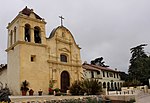G. T. Marsh and Sons

G.T. Marsh and Sons, also known as Marsh's Oriental Art Store, is a historic building in Monterey, California that is listed on the National Register of Historic Places. It was listed on the National Register in 2007; the listing included one contributing building and one other contributing structure.It was built in 1928 by Japanese craftsmen and includes Sichuan Chinese architecture. According to its NRHP nomination, it is a "large, mysterious, architecturally outstanding, building" that is significant for representing "a highly artistic and specialized style that is unique to Monterey and possibly to the nation, and [which] has become one of the symbols of the City's important and colorful past."
Excerpt from the Wikipedia article G. T. Marsh and Sons (License: CC BY-SA 3.0, Authors, Images).G. T. Marsh and Sons
Fremont Street, Monterey
Geographical coordinates (GPS) Address Nearby Places Show on map
Geographical coordinates (GPS)
| Latitude | Longitude |
|---|---|
| N 36.595277777778 ° | E -121.88944444444 ° |
Address
Fremont Street 580
93940 Monterey
California, United States
Open on Google Maps








